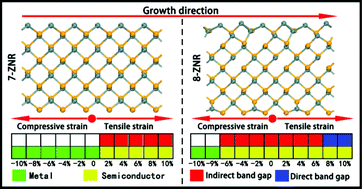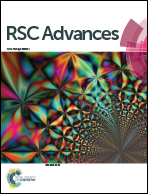Edge-, width- and strain-dependent semiconductor–metal transition in SnSe nanoribbons†
Abstract
First-principles calculations were employed to explore the electronic properties of SnSe nanoribbons. Our results showed that a semiconductor–metal or metal–semiconductor transition can be realized in SnSe nanoribbons by controlling the edge shape, width parameter and different levels of strain. It was found that the transition always occurs in SnSe nanoribbons with a zigzag edge (ZNR). With the width parameter of ZNRs less than 8, their optimized structures are perfect (P-structures) without any Sn–Se bond breaking and the electronic calculations demonstrate they display a metallic character. However, the structures became deformed (D-structures) with some Sn–Se bond rupture when tensile strain was applied, accompanied by the transition occurring from metal to indirect band gap semiconductors. On the other hand, compressive strain cannot induce the metal–semiconductor transition as ZNRs still keep their P-structures. With the width parameter greater than or equal to 8, ZNRs change to D-structure exhibiting a semiconductive feature at equilibrium state. The semiconductor–metal transition cannot be induced through applying tensile strain while a certain extent of compressive strain can trigger it. The localized–delocalized partial charge distribution of the conduction band minimum near the strained domains can be used to explain the metal–semiconductor or semiconductor–metal transition in SnSe ZNRs. Our results suggest that the SnSe ZNRs have potential applications in nanoelectromechanical sensors and switches, which will promote further experimental investigations on SnSe and other fascinating graphene-like metal chalcogenides.


 Please wait while we load your content...
Please wait while we load your content...